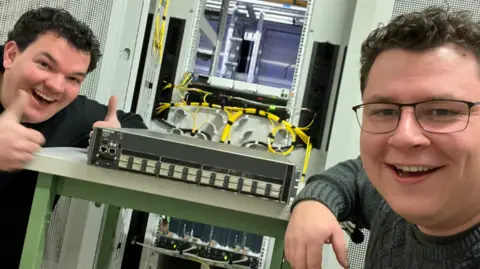A Quantum Leap in Data Speed: Transforming the Scientific Landscape
In a monumental leap for data transmission in the scientific community, engineers at CERN have achieved an extraordinary milestone. Early this year, on what was indeed a nerve-wracking day, two network engineers executed a command that would forever change how data flows from the world’s largest science experiment, the Large Hadron Collider (LHC). The result? A staggering data link capable of reaching speeds of 800 gigabits per second (Gbps), dwarfing conventional internet speeds by an astronomical margin of over 11,000 times.
Celebrating Success at CERN
The scene was electric. According to Joachim Opdenakker from SURF, the Dutch IT association collaborating with CERN, the moment the figures flashed across the screen, “There was high-fiving involved.” Such jubilation was warranted; this groundbreaking link promises to streamline scientists’ access to the LHC’s vast troves of data, thus accelerating research and discovery.
 Engineers at CERN celebrate a new high-speed data link.
Engineers at CERN celebrate a new high-speed data link.
Subsequent tests, equipped with cutting-edge technology courtesy of Nokia, confirmed that these record speeds were not merely a dream but a tangible reality. Mr. Verheul, another engineer involved in this endeavor, described the Nokia transponder as “like a celebrity,” highlighting the limited availability and high demand for such advanced equipment.
The Future of Data and Research
While the achieved speed is incredibly fast, it’s worth noting that future innovations are already afoot. Networking experts are currently working on fiber optic systems pushing data rates into the stratosphere—many petabits per second—equating to around 300 million times the average UK broadband connection speed. Such developments raise fascinating questions about the potential applications of this incredible bandwidth. With engineers continuously striving for faster connections, one can’t help but ponder: how will we utilize this seemingly limitless capacity?
Cloud Innovations: CAMS and Google Join Forces
In another significant advancement within technology, the financial sector is witnessing its transformation with the investment in cloud-native platforms. Computer Age Management Services Ltd (CAMS) has teamed up with Google Cloud to modernize the asset management landscape in India.
This ambitious initiative aims to overhaul the largest platform in the Indian asset management industry over the next five years, equipping it with modern capabilities essential for handling a burgeoning marketplace. According to CAMS Managing Director Anuj Kumar, this venture is not just about modernization; it’s a necessary step towards embracing a distributed, service-oriented architecture that leverages emerging technologies.
)
Kumar remains optimistic about the initiative, noting that while their current platform manages about 68% market share in mutual funds, tackling the needs of an evolving ecosystem is paramount. Each module of this updated platform will be deployed in phases, ensuring the continuity of services and compliance with regulatory standards.
Green Energy Initiatives: The Future of Offshore Wind
The renewable energy sector is also marking significant strides with projects like the PREDICT 2.0 initiative led by the Salamander Offshore Wind Farm. This venture, a collaboration involving Ørsted, Simply Blue Group, and Subsea7, seeks to harness the power of wind while deepening our understanding of environmental impacts, particularly fish migration.
Situated off the coast of Peterhead, this 100 MW floating wind project is pioneering not only the generation of renewable energy but also the deployment of sophisticated environmental monitoring equipment. Such initiatives reflect a growing recognition of the ecological considerations that accompany energy production, symbolizing a step forward in achieving sustainable development goals.
 Floating wind farms: a blend of renewable energy and environmental science.
Floating wind farms: a blend of renewable energy and environmental science.
Conclusion: A Future Connected and Sustainable
The innovations stemming from CERN’s data speed upgrades to CAMS’ cloud platform overhaul and the Salamander Offshore Wind initiative are indicative of a broader trend—society is on the cusp of a technological revolution. As we enhance our capacity to manage and utilize colossal data streams while simultaneously addressing ecological sustainability, we might find ourselves better equipped to solve the challenges of our times. With the rapid technological advancements reshaping industries, the future indeed looks connected and promising.
As we look to the horizon, the possibilities are not just exciting; they are essential for the ongoing scientific and societal progress.


 Photo by
Photo by 












